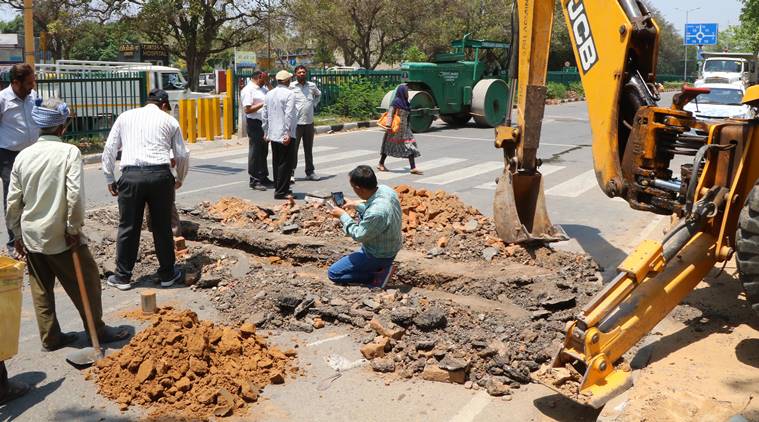 Experts of Central Road Research Institute inspect the road near GMSH in Sector 16 , Chandigarh, on Thursday. (Express photo by Kamleshwar Singh)
Experts of Central Road Research Institute inspect the road near GMSH in Sector 16 , Chandigarh, on Thursday. (Express photo by Kamleshwar Singh)
THE CHANDIGARH Administration on Thursday began the process of conducting a study through experts of the Central Road Research Institute (CRRI) to assess whether it would be possible to recarpet Madhya Marg (V-2 road) without having any effect on the level of the road. Because of the repeated recarpeting over the years, the level of Madhya Marg has increased compared to adjoining roads, which causes waterlogging during rains. The study also aims to suggest an adequate level of the road, after recarpeting, so that it does not lead to waterlogging.
A team, under the supervision of Senior Scientist with CRRI, Dr Ambika Behl, collected six samples from six different places between Panjab University and Grain Market moving towards Housing Board Light point on the first day of the two-day study. Road samples are being collected with the help of drill machines and JCB machines. Madhya Marg is in the category of V-2 road (state highway) as it is linked to the Kalka-Shimla national highway.
Chief Engineer (UT) Mukesh Anand said, “Recarpeting of roads is done every five years. The need for this study arose when we observed that repeated recarpeting of the main roads every five years is also increasing the level of the main roads compared to other roads, including slow-carriageways that run parallel to these roads; and internal roads of sectors. It is creating imbalance in the level of the road network and causing waterlogging. According to road construction rules, there should not be a huge difference in the level of main and adjoining roads of a city. This study is on a trial basis. If CRRI manages to give us substantial solutions, we will allow the team to conduct a study on other roads, including Dakshin Marg, Purv Marg, Vikas Marg and other heavy-traffic roads. The CRRI is a central government agency and we paid around Rs 10 lakh to the institute for this study.”
“Today was the first day of the study. It will take around two months to analyse the road samples and the volume of vehicles on Madhya Marg,” Behl told Chandigarh Newsline.
The team will again collect samples from Grain Market to PU moving towards PGI on Friday. It is for the first time that the Chandigarh Administration has invited a team of experts from CRRI to conduct a study to ascertain whether the recarpeting of the road could be done without increasing the road level.
Commuters were advised to use slip roads from PU to the Grain Market roundabout when samples were being collected by the CRRI team at Madhya
Marg on Thursday. Later, commuters were allowed to travel from the main roads as vehicle pressure increased. Traffic police were deployed. DSP (Traffic) Yashpal Vinayak said, “On Friday, commuters will have to use slow carriage roads from the Grain Market roundabout to the Panjab University roundabout from Panchkula to Chandigarh side.”